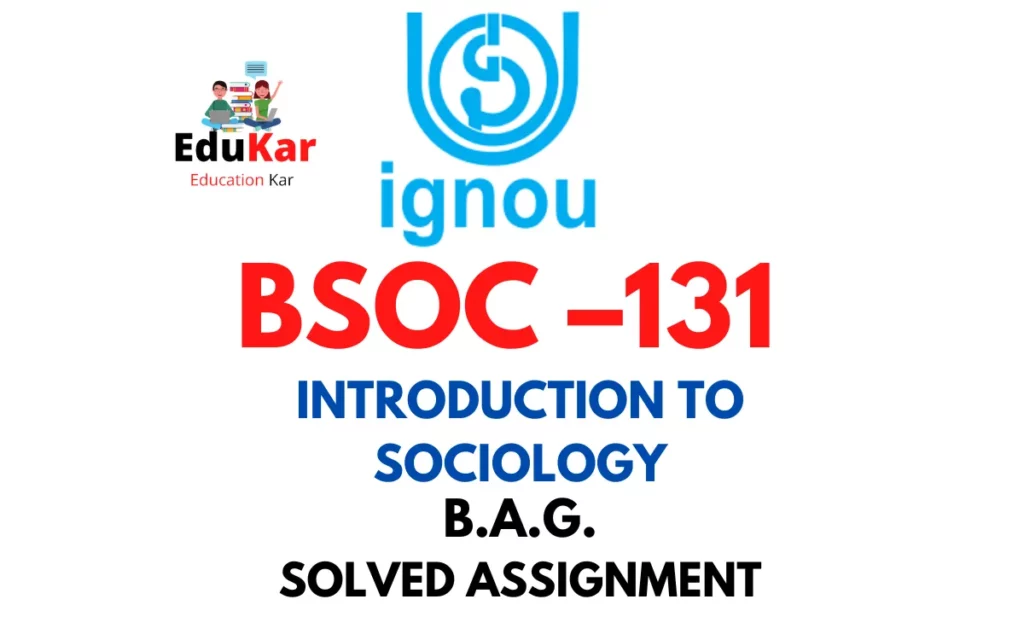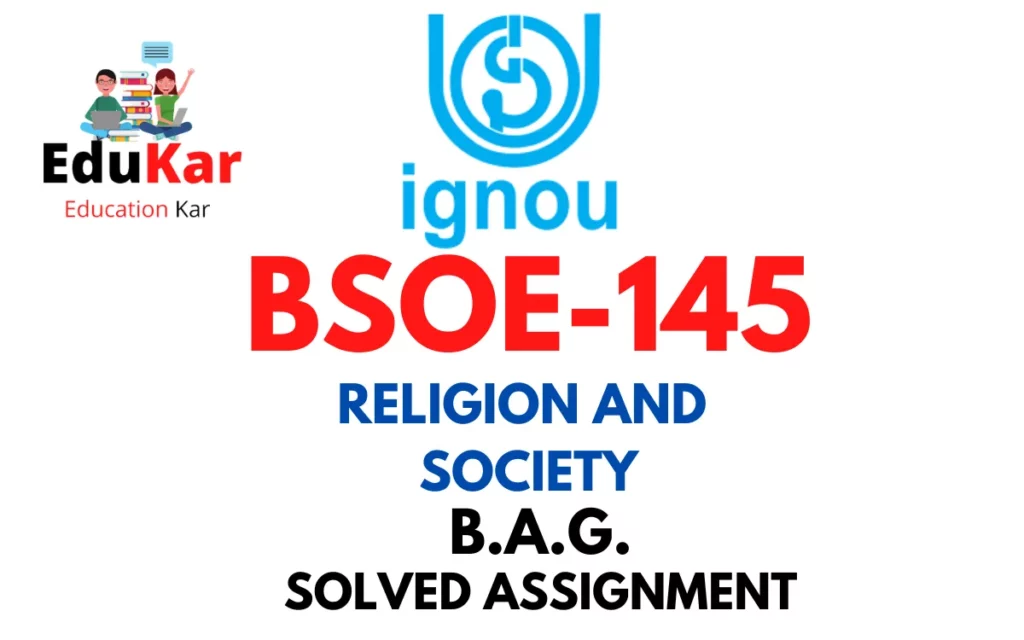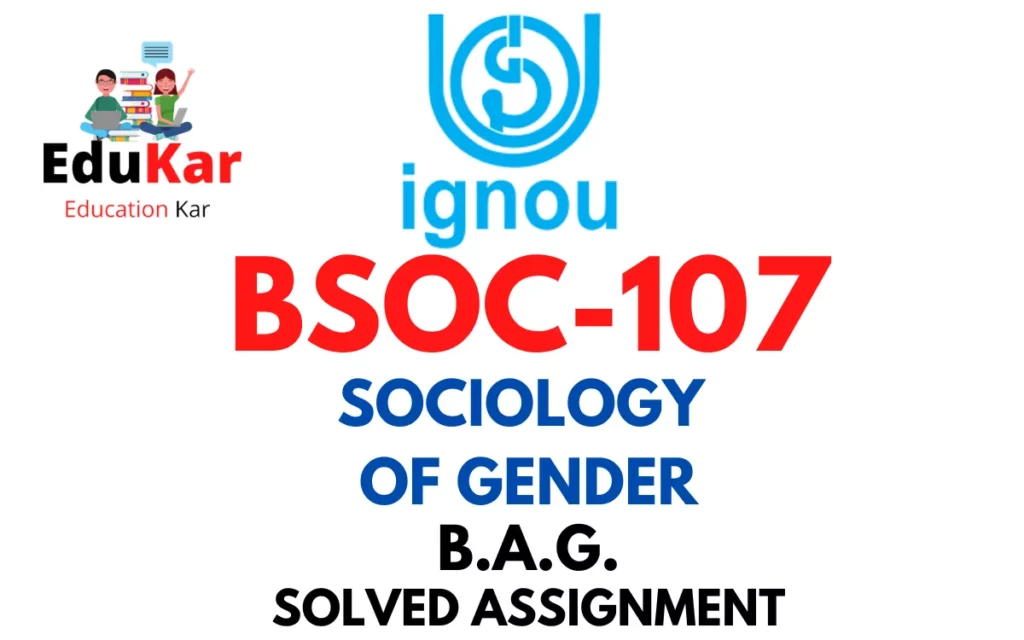Contents
- 1 Assignment A
- 2 Answer the following Descriptive Category questions in about 500 words each. Each question carries 20 marks.
- 3 1. What is Liberal Feminism? Examine its approach.
- 4 2. Explain the interpretive approach of Max Weber.
- 5 Assignment B
- 6 Answer the following Middle Category questions in about 250 words each. Each question carries 10 marks.
- 7 3. Discuss the conflict theory of Dahrendorf.
- 8 4. Discuss George Herbert Mead’s view on symbolic interactionism.
- 9 5. Describe the key concepts used by Durkheim to understand.
- 10 Assignment C
- 11 Answer the following Short Category questions in about 100 words each. Each question carries 6 marks.
- 12 6. What is mechanical solidarity?
- 13 7. What is alienation?
- 14 8. What is social change?
- 15 9. What is phenomenology?
- 16 10. What is structuralism?
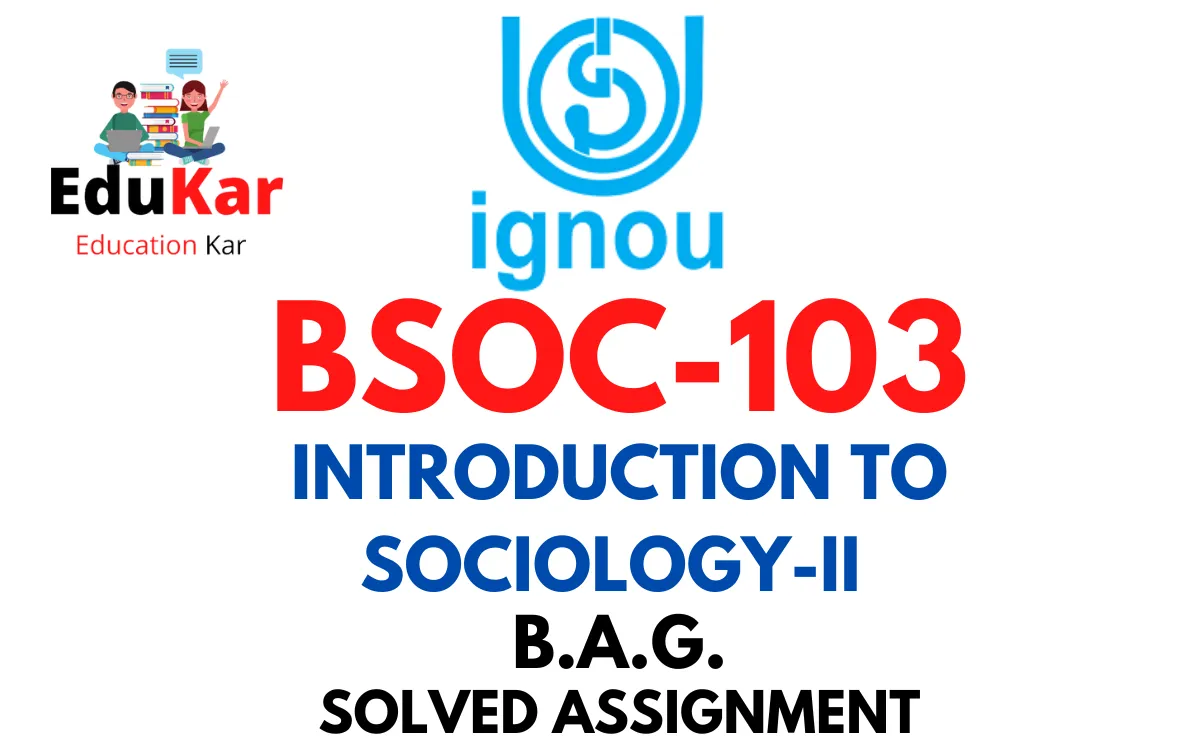
| Title | BSOC-103: IGNOU BAG Solved Assignment 2022-2023 |
| University | IGNOU |
| Degree | Bachelor Degree Programme |
| Course Code | BSOC-103 |
| Course Name | INTRODUCTION TO SOCIOLOGY-II |
| Programme Name | Bachelor of Arts (General) |
| Programme Code | BAG |
| Total Marks | 100 |
| Year | 2022-2023 |
| Language | English |
| Assignment Code | ASST /TMA /2022-23 |
| Assignment PDF | Click Here |
| Last Date for Submission of Assignment: | For June Examination: 31st April For December Examination: 30th September |
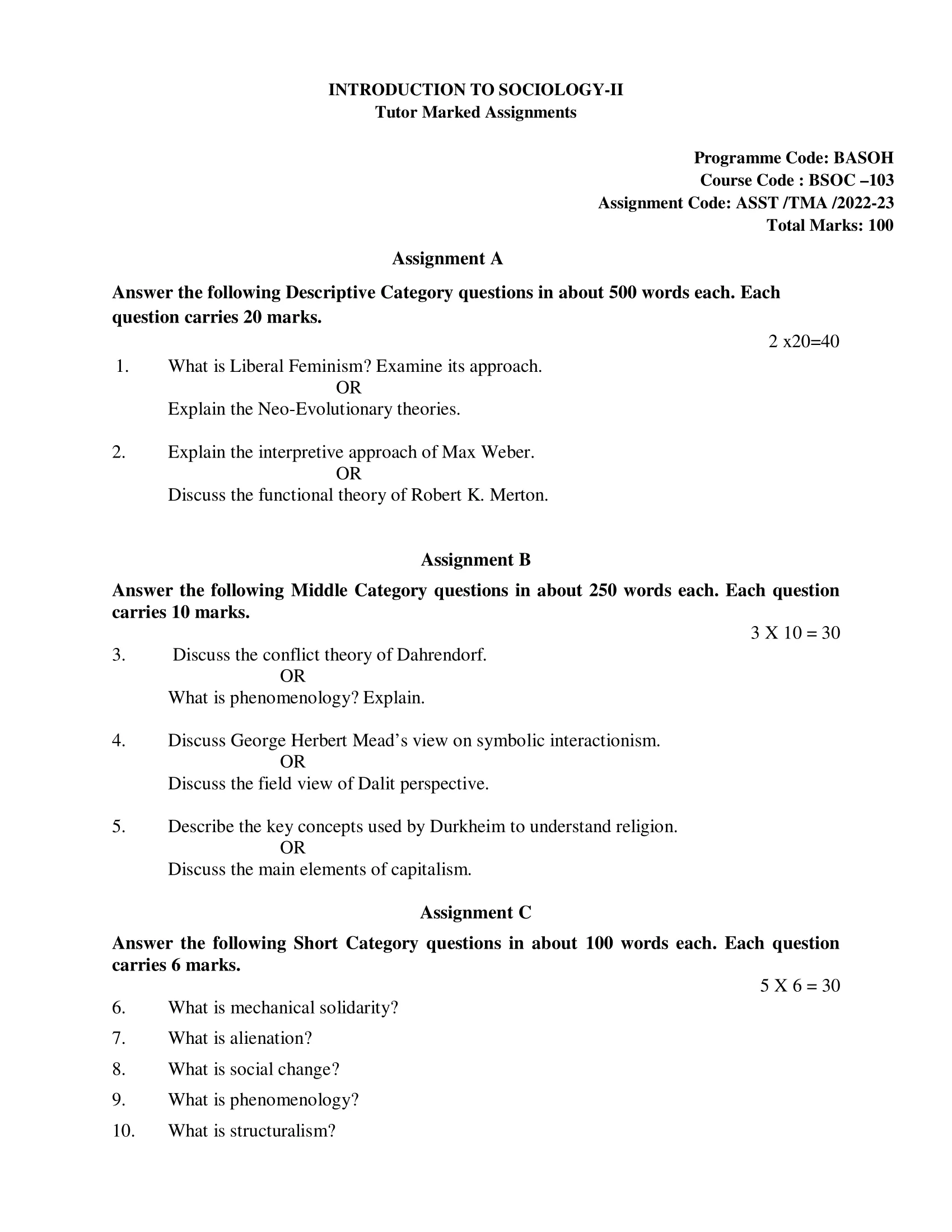
Assignment A
Answer the following Descriptive Category questions in about 500 words each. Each question carries 20 marks.
1. What is Liberal Feminism? Examine its approach.
Ans: Liberal feminism is a philosophical and political movement that aims to establish gender equality through reformist, legal and political means. Liberal feminists believe that gender inequality is a result of societal institutions and traditions that limit women’s opportunities and choices. The movement emerged in the late 19th and early 20th centuries in the United States and the United Kingdom and has since spread across the world.
The approach of liberal feminism is centered around the idea of equal rights and opportunities for women. Liberal feminists believe that women should be able to pursue their individual interests and abilities without facing discrimination based on their gender. They also believe that women should have the same legal and political rights as men, including the right to vote, the right to work, and the right to receive equal pay for equal work.
Liberal feminists argue that gender inequality is reinforced by social, economic, and political institutions that are rooted in patriarchal values. These values assign gender roles that limit women’s choices, create gender stereotypes that reinforce sexist attitudes, and deny women the same opportunities and rewards as men.
To address gender inequality, liberal feminists focus on changing the laws and institutions that limit women’s opportunities and rights. They advocate for gender-neutral legislation that would treat women and men equally, as well as for affirmative action policies that would help to overcome the historical disadvantage that women face in various fields. They also support policies that aim to eliminate the gender wage gap and promote work-family balance, such as parental leave and flexible work arrangements.
Liberal feminists also focus on changing cultural attitudes that contribute to gender inequality. They work to challenge gender stereotypes and promote the idea that women and men can and should pursue any occupation or interest they choose. They also advocate for education and media campaigns that promote gender equality and raise awareness of the ways in which gender discrimination can limit women’s opportunities and choices.
One criticism of liberal feminism is that it focuses too much on individual rights and fails to address the systemic roots of gender inequality. It also tends to focus on the experiences of white, middle-class women and overlook the intersectional experiences of women who face multiple forms of discrimination based on their race, class, sexuality, or ability. Despite these criticisms, liberal feminism remains an influential and important movement that has helped to establish many legal and political reforms that have advanced women’s rights and gender equality.
2. Explain the interpretive approach of Max Weber.
Ans: Max Weber was a German sociologist, philosopher, and political economist who is widely regarded as one of the founding fathers of sociology. Weber’s interpretive approach to social research is a key aspect of his work and is characterized by an emphasis on the subjective meanings and interpretations that people attach to their actions and social interactions.
Weber’s interpretive approach is based on the assumption that human beings are social actors who create and interpret the meanings of their actions and the social structures in which they operate. According to Weber, social reality is not just an objective set of facts and structures, but is also constructed through human interpretations and meanings. These meanings are subjective and are shaped by individuals’ experiences, cultural backgrounds, and social contexts.
Weber argued that social scientists must take these subjective meanings into account when studying social phenomena. He believed that researchers must use empathy to understand how people interpret and experience their social world. This involves putting oneself in the shoes of others and trying to understand their perspectives and motivations.
Weber also emphasized the importance of understanding the historical and cultural contexts in which social phenomena occur. He believed that the meanings and interpretations of social actions and structures are shaped by the historical and cultural contexts in which they are situated. Therefore, social scientists must understand the specific historical and cultural factors that shape people’s experiences and interpretations.
To study social phenomena from an interpretive perspective, Weber developed the concept of “verstehen,” which refers to understanding the subjective meanings that individuals attach to their actions and interactions. This involves conducting in-depth interviews, observing social interactions, and analyzing documents and artifacts to understand the meanings and interpretations that people attach to their social world.
Weber’s interpretive approach also involves the use of ideal types, which are conceptual constructs that represent the typical characteristics of a particular social phenomenon. Ideal types are not meant to be an accurate representation of reality, but rather a tool for understanding and comparing social phenomena.
Weber’s interpretive approach has been influential in shaping modern sociology and has been applied to a wide range of social phenomena, including religion, bureaucracy, and capitalism. The interpretive approach has also been used in other disciplines, such as anthropology and psychology.
One criticism of Weber’s interpretive approach is that it can be difficult to generalize findings from a small sample of individuals to a larger population. It can also be challenging to identify and understand the subjective meanings and interpretations of individuals who may have different cultural and social backgrounds than the researcher. Despite these challenges, Weber’s interpretive approach remains an important and influential perspective in the field of sociology and social research.
Assignment B
Answer the following Middle Category questions in about 250 words each. Each question carries 10 marks.
3. Discuss the conflict theory of Dahrendorf.
Ans: The conflict theory of Ralf Dahrendorf, a German sociologist, focuses on the concept of power and how it is distributed within societies. Dahrendorf’s theory argues that power is a fundamental aspect of society and that it creates tensions and conflicts among individuals and groups with different levels of power.
According to Dahrendorf, individuals and groups with power will try to maintain their power and use it to their advantage, while those without power will try to gain power and challenge the existing power structures. This struggle for power creates conflict, which is an inherent feature of society. Dahrendorf argues that conflict is not necessarily negative, as it can lead to social change and progress.
Dahrendorf identifies two types of conflict in society: the first is a “manifest conflict” that is visible and easily identifiable, such as strikes, protests, and revolutions. The second type of conflict is a “latent conflict” that is less visible and often operates beneath the surface. Latent conflicts are rooted in social inequalities and power imbalances that exist in society.
Dahrendorf’s theory also argues that power is not evenly distributed in society, and that different groups have different levels of power. Inequality of power can lead to social stratification, where some groups have more access to resources, opportunities, and social status than others. This stratification creates a hierarchy in society that is maintained through power struggles and conflict.
4. Discuss George Herbert Mead’s view on symbolic interactionism.
Ans: George Herbert Mead was an American sociologist and philosopher who developed the theory of symbolic interactionism, which focuses on the way people create meaning through social interaction and communication. Mead’s view on symbolic interactionism emphasizes the importance of language, symbols, and gestures in shaping our perception of reality and constructing our sense of self.
Mead believed that humans are fundamentally social beings and that our sense of self develops through our interactions with others. According to Mead, individuals engage in a process of “taking the role of the other” as they learn to understand and anticipate how others will perceive and respond to their actions. This process allows individuals to develop a sense of self, which is shaped by the social context in which they exist.
Mead also emphasized the importance of symbols in communication and interaction. Symbols are arbitrary and are assigned meaning through social agreement, which allows individuals to communicate and understand each other. Mead argued that symbols play a critical role in constructing our sense of reality and that we use symbols to interpret and respond to the world around us.
Furthermore, Mead believed that gestures play an important role in social interaction. Gestures are nonverbal symbols that communicate meaning, and they are used to convey emotions, attitudes, and intentions. According to Mead, gestures are an essential part of communication, and they are used to establish and maintain social relationships.
5. Describe the key concepts used by Durkheim to understand.
Ans: Emile Durkheim was a French sociologist who is considered to be one of the founding fathers of modern sociology. Durkheim’s work focused on the study of society and the ways in which it shapes individual behavior and attitudes. He developed several key concepts that are still used in sociology today to understand the dynamics of social life.
- Social Facts: Durkheim argued that social facts are external to the individual and exist independently of individual consciousness. Social facts are the ways in which people behave and interact with each other that are shared by members of a particular society. Examples of social facts include social norms, values, and institutions. Social facts are crucial for the functioning of society and help to maintain social order.
- Division of Labor: Durkheim believed that the division of labor was a crucial feature of modern societies. As societies become more complex and specialized, people become more interdependent on one another. The division of labor leads to increased efficiency and productivity, but it can also lead to social and economic inequalities.
- Anomie: Anomie is a state of normlessness and a lack of social regulation that occurs when there is a breakdown in social norms and values. Durkheim argued that anomie is a result of rapid social change and the breakdown of traditional social structures. It can lead to social disorder, deviance, and other social problems.
- Collective Consciousness: Collective consciousness refers to the shared beliefs, values, and attitudes that exist within a society. Durkheim believed that collective consciousness is a crucial part of social integration and that it helps to maintain social order. Collective consciousness is often expressed through social institutions such as religion, education, and the family.
- Social Solidarity: Social solidarity refers to the degree to which members of a society are integrated into a collective group. Durkheim identified two types of social solidarity: mechanical and organic. Mechanical solidarity is based on similarity and shared values, while organic solidarity is based on interdependence and the division of labor.
Assignment C
Answer the following Short Category questions in about 100 words each. Each question carries 6 marks.
6. What is mechanical solidarity?
Ans: Mechanical solidarity is a concept introduced by the French sociologist Emile Durkheim to describe a form of social cohesion that is based on the similarity of individuals within a society. In societies characterized by mechanical solidarity, individuals share similar beliefs, values, and norms, and their social interactions are governed by strict rules and traditions. This type of social cohesion is often found in small, traditional societies, where individuals are closely connected and have little division of labor or specialization. Durkheim contrasted mechanical solidarity with organic solidarity, which is based on the interdependence and specialization of individuals within a more complex society.
7. What is alienation?
Ans: Alienation is a concept that refers to the feeling of being disconnected or estranged from oneself, other people, or the world. It is a social and psychological phenomenon that can result from a variety of experiences, including work, relationships, and social structures.
In the context of work, alienation refers to the feeling of being disconnected from the products of one’s labor and the process of work itself. This can occur when workers are separated from the final product of their labor, work in highly repetitive and dehumanizing tasks, or have little control over their work environment. According to Marx, this type of alienation is a result of the exploitation of workers by capitalists who view them as a means of production rather than as human beings.
Alienation can also occur in relationships when individuals feel disconnected or estranged from others. This can result from experiences of social isolation, rejection, or a lack of social support. In this context, alienation is often linked to feelings of loneliness, depression, and anxiety.
Ans: Social change refers to any significant alteration in the social structure or organization of a society, group or individual. Social change can occur at various levels, from small-scale changes in individual attitudes and behavior to large-scale changes in the structure of society or the world as a whole. Social change can be driven by a variety of factors, including technological advances, economic shifts, political movements, cultural changes, and environmental pressures.
Social change is an important area of study in sociology, as it is closely linked to social problems and issues such as poverty, inequality, and social conflict. Understanding the causes and consequences of social change is essential for creating effective social policies and programs, and for addressing the complex challenges facing individuals and societies in the modern world.
9. What is phenomenology?
Ans: Phenomenology is a philosophical and social scientific approach that emphasizes the study of subjective experience, meaning, and consciousness. Phenomenology seeks to describe and understand the structures of subjective experience, rather than trying to explain them in terms of external causes. It is concerned with the way that individuals perceive and experience the world around them, and how they give meaning to their experiences.
Phenomenology has had a significant impact on social science research, particularly in the areas of psychology, sociology, and anthropology. It is used to study a wide range of phenomena, including social interactions, emotions, cultural practices, and individual experiences of mental health and illness. Phenomenology is an important tool for understanding the subjective and often complex experiences of individuals and groups, and for exploring the ways in which social and cultural factors shape those experiences.
10. What is structuralism?
Ans: Structuralism is a theoretical approach in sociology that emphasizes the importance of social structures and institutions in shaping individual behavior and attitudes. According to structuralism, individuals are not autonomous actors who make choices based on their own free will, but rather are influenced by the social structures and institutions that surround them. Structuralism seeks to understand how social structures and institutions operate, how they are related to each other, and how they shape individual behavior and attitudes. It has been criticized for downplaying the agency of individuals and for being overly deterministic in its approach.
How to Download BSOC-103 Solved Assignment?
You can download it from the www.edukar.in, they have a big database for all the IGNOU solved assignments.
Is the BSOC-103 Solved Assignment Free?
Yes this is absolutely free to download the solved assignment from www.edukar.in
What is the last submission date for BSOC-103 Solved Assignment?
For June Examination: 31st April, For December Examination: 30th October






